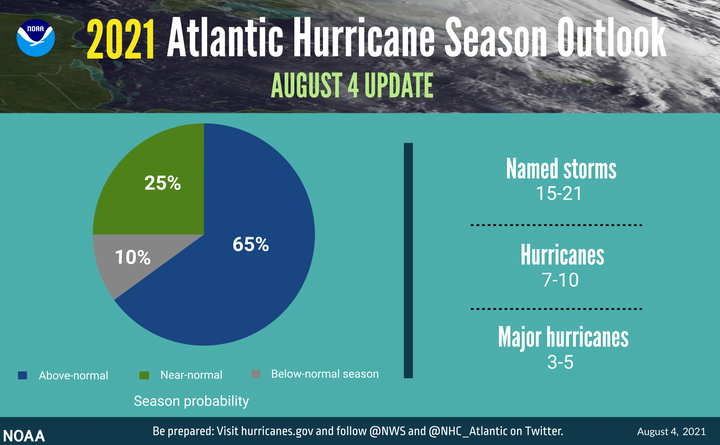There’s a heightened chance that this year’s Atlantic hurricane season will be above average with more named storms and hurricanes than previously predicted, the National Oceanic and Atmospheric Administration said Wednesday.
The latest outlook for the six-month season, which began June 1 and ends Nov. 30, includes 15 to 21 named storms, seven to 10 hurricanes, and three to five major hurricanes reaching a category of 3, 4 or 5, NOAA said.
So far this year, there have been five named storms, one of which became a hurricane and was the earliest fifth-named storm on record. These past storms are included in the total number of storms forecast for the season.
“After a record-setting start, the 2021 Atlantic hurricane season does not show any signs of relenting as it enters the peak months ahead,” said Rick Spinrad, NOAA administrator.
NOAA’s latest forecast is a slight jump from the previous forecast it made in late May, when it predicted 13 to 20 named storms and six to 10 hurricanes. The number of major hurricanes predicted has not changed.
“Now is the time to be vigilant about your preparedness plans and potential actions,” Matthew Rosencrans, lead seasonal hurricane forecaster at NOAA’s Climate Prediction Center, said at a news conference. “As we have seen in recent years, threats from hurricanes are not limited to damaging winds but also dangerous storm surge and torrential rain and wind flooding.”
Overall, the likelihood of an above-normal 2021 season is now 65% ― up from a 60% projection in May. If the prediction is accurate, 2021 would be the sixth consecutive year to feature above-average storm activity in the Atlantic.
Fortunately, due to sea surface temperatures being closer to average across the Atlantic region where storms typically develop, this year is not expected to be as active as last year, said Rosencrans.
NOAA last month also issued a La Niña Watch, with a 55% chance of it emerging during the September-November period and lasting through winter.
This climate pattern tends to lead to drought in the southern U.S. and heavy rains and flooding in the Pacific Northwest and Canada. While it tends to suppress hurricane activity along the Pacific, it can lead to more and stronger Atlantic storms, particularly in the latter half of the year, according to NOAA.
The chance of La Niña was factored into NOAA’s hurricane outlook for this year, said Rosencrans.
NOAA’s upgraded forecast comes as the National Hurricane Center monitors two disturbances brewing in the Atlantic. One of the disturbances is said to have the potential to turn into a tropical depression by early next week.
RELATED…
Related
Trending
Source: Read Full Article











